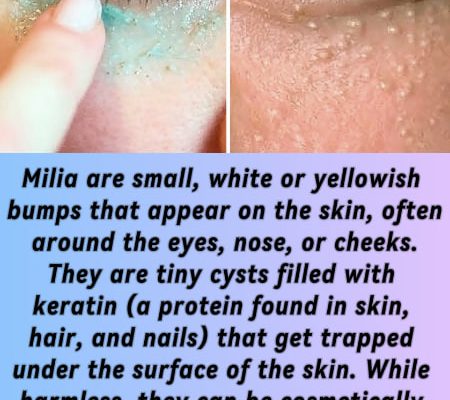Milia are small, white or yellowish bumps that appear on the skin, often around the eyes, nose, or cheeks.1 They are tiny cysts filled with keratin (a protein found in skin, hair, and nails) that get trapped under the surface of the skin.2 While harmless, they can be cosmetically bothersome.3

Important Warning: Do NOT pick, poke, or try to squeeze milia at home with your fingernails or any sharp objects (like needles). Unlike pimples, milia are not pores filled with pus that can be “popped.”4 Attempting to extract them yourself can lead to skin damage, infection, inflammation, hyperpigmentation (dark spots), and permanent scarring.5 Professional extraction is done by dermatologists or trained estheticians using sterile tools and proper techniques to minimize these risks.6
While professional removal is the most effective and safest method for immediate results, here are safe, easy, and scar-free ways to manage and help get rid of milia at home over time, primarily by encouraging natural exfoliation and preventing new ones from forming:
1. Gentle Cleansing and Exfoliation:
- Cleanse Daily: Wash your face twice a day with a gentle, non-comedogenic cleanser (one that won’t clog pores). This helps remove dirt, oil, and dead skin cells that can contribute to milia formation.7
- Gentle Exfoliation (Chemical Exfoliants are Best): This is key to helping milia resolve.8 Exfoliation helps shed dead skin cells that trap keratin.
- Alpha Hydroxy Acids (AHAs): Ingredients like glycolic acid or lactic acid found in cleansers, toners, or mild peels can help loosen dead skin cells.9 Start with a low concentration and use 2-3 times a week, gradually increasing frequency if your skin tolerates it.
- Beta Hydroxy Acids (BHAs): Salicylic acid is a BHA that can penetrate oil and help exfoliate inside the pores, which can be beneficial for preventing clogged pores and potentially helping with milia.10
- Avoid Harsh Physical Scrubs: While exfoliation is good, harsh physical scrubs can irritate the skin and potentially worsen the situation.11 Stick to gentle chemical exfoliants
2. Topical Retinoids (Vitamin A Derivatives):
- How they work: Retinoids (like retinol or adapalene, which is available over-the-counter as Differin) promote cell turnover, helping the skin to exfoliate more effectively and loosen the keratin plugs in milia.12 They can also prevent new milia from forming.
- How to use: Start with a low-strength retinol cream or serum a few times a week, applying it to clean, dry skin at night. Gradually increase frequency as your skin tolerates it.
- Important: Retinoids can make your skin more sensitive to the sun, so always use a broad-spectrum sunscreen with SPF 30 or higher daily when using these products. They can also cause initial dryness, redness, or flaking.
3. Steaming Your Face:
- How it works: Warm steam can help to soften the skin and loosen the contents of the milia, making it easier for them to eventually work their way out.13
- How to use: Boil water and pour it into a bowl. Carefully position your face about 6-8 inches above the bowl (be cautious not to burn yourself). Drape a towel over your head and the bowl to create a tent, trapping the steam. Steam for 5-10 minutes. Follow up with your gentle cleanser or exfoliant.
4. Proper Skincare Habits & Prevention:
- Non-Comedogenic Products: Always choose makeup, moisturizers, and sunscreens that are labeled “non-comedogenic” or “non-acnegenic.” This means they are formulated not to clog pores.
- Avoid Heavy, Oily Creams: Especially around the eyes, heavy or rich creams can contribute to milia formation by trapping dead skin cells.14 Opt for lighter, gel-based, or water-based moisturizers.
- Sun Protection: Sun damage can thicken the skin and potentially worsen milia. Use a broad-spectrum sunscreen with SPF 30+ daily, even on cloudy days.
- Patience is Key: Milia can take weeks or even months to resolve naturally with consistent home care.15 Be patient and persistent with your routine.
- Don’t Overdo It: Too much exfoliation or using products that are too strong can irritate your skin and potentially make milia worse or cause other skin issues.16 Start slow and listen to your skin.
When to See a Professional:
While home remedies can help, milia can be stubborn. You should consider seeing a dermatologist or a qualified esthetician if:
- The milia are persistent and don’t improve with home treatment.
- You have a large number of milia.
- Milia are in delicate areas like the eyelids (never try to remove these yourself).17
- You are concerned about the appearance and want faster results.
A professional can perform safe and effective extraction using a sterile needle or lancet to gently “deroof” the milium and remove its contents, often with immediate results and minimal to no scarring when done correctly.18 They can also recommend other treatments like chemical peels, microdermabrasion, or retinoid prescriptions.

